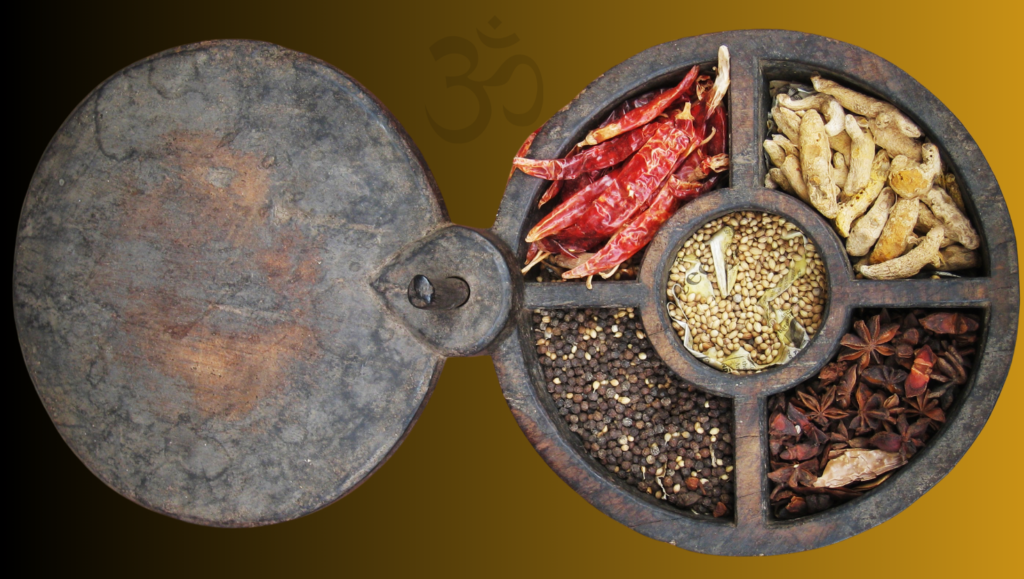
Vata Churna
Ayurveda: The Ancient Science of Life
Rooted in the Vedic traditions of India over 5,000 years ago, Ayurveda is a holistic system of healing that views the body, mind, and spirit as interconnected expressions of nature. Each blend in this collection is crafted to honor that lineage. These are not just remedies; they are rituals of return.


Vata Churna
Ancient Origin: 5,000 years ago in Sanskrit text Charaka Samhita & Ashtanga Hridayam
The root beneath the wind.
Some say this blend was stirred by healers who walked barefoot through forests, carrying warmth in their pockets for those who forgot the ground beneath them. Vata Churna is not a cure—it is a return. A slow exhale. A weighted step. A reminder that even when the mind wanders, the body remembers the way home.It was never meant to fight the wind. Only to hold it.

Traditional Properties
Each ingredient in Vata Churna was chosen not only for its warming nature, but for the way it brings presence to the scattered, anxious, and unmoored. These are not just spices—they are anchors. Each one whispers to the nervous system, the belly, the breath – ‘Do not rush.’
‘Settle.’
Ginger
- Warms the limbs, ignites digestion, and awakens circulation.
- Ginger is a member of the Zingiberaceae family, which includes turmeric, cardamom, and galangal.
- Revered across healing traditions, ginger was once used to guide lost spirits back to the body.
Cinnamon
- Improves warmth and circulation, stabilizes blood sugar.
- Cinnamon is a spice made from the bark of the Cinnamomum verum (True Cinnamon) tree.
- Called “fire bark” in some traditions, cinnamon was burned as an offering to ward off cold spirits and indecision.
Fennel
- Soothes the gut, eases bloating, and balances sweetness with clarity.
- Fennel is a perennial herb of the carrot family grown for its aromatic shoots, leaves, and seeds.
- In ancient rites, fennel stalks were carried as symbols of victory and renewal.
Cumin
- Kindles digestive fire, dispels stagnation.
- Cumin, (Cuminum cyminum)is an annual plant of the parsley family.
- Carried in pouches by desert travelers as both food and protection against the unseen.
- It carries the memory of every place it’s been.
Asafoetida
- Strengthens digestion, prevents gas and bloating.
- Hing is the dried resin of a perennial herb called Ferula, which is a plant in the fennel family.
- Once considered the “food of the gods,” its pungency was said to drive out sickness and clear the mind.
Ajwain
- Deeply warming, sharpens the senses, improves appetite.
- Ajwain is the seed of an annual herb called Trachyspermum ammi. It belongs to the Apiaceae family, which also includes caraway, cumin, and fennel.
- Traditionally used in post-partum healing, ajwain grounds new mothers back into their bodies.
Sea Salt
- Mineral-rich and grounding, enhances assimilation of all other ingredients.
- Salt has long been used in ritual to protect, preserve, and purify.
Black Pepper
- Invites deeper warmth, enhances absorption.
- Peppercorns were so prized in ancient trade they were once used to pay rent and taxes in gold’s stead.

Flavor Profile
Flavor Notes:
- Warm
- Spiced
- Slightly pungent
- Earthy
- Saline depth
Intentional Uses:
- Use during colder seasons, times of anxiety, or post-travel.
- Sprinkle onto warm food or brew into broths.
- Best enjoyed with stillness and breath.
- Let it bring you back to where your feet meet the soil.

Elemental Signature
In the context of The Forgotten Blend, an elemental signature refers to the core energy and connection a blend has with the natural world.
Fire and Earth — transformation and grounding.
This blend tempers wind, eases flight, and roots the scattered soul back into the moment. It is both ember and stone.

“As calm water becomes clear when it is still, so does the mind become clear when it is peaceful.”
– The Wizard’s Table Codex


